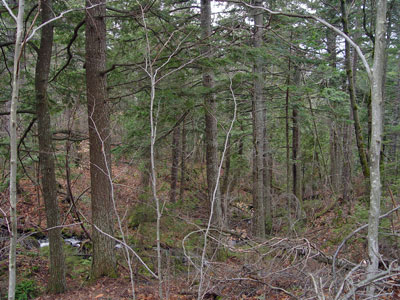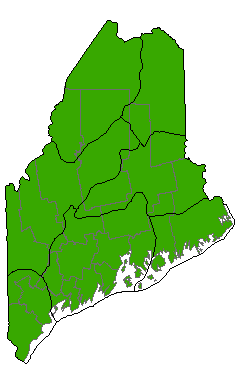DACF Home → Bureaus & Programs → Maine Natural Areas Program → Communities, Plants, and Animals → Natural Community Fact Sheets → Hemlock Forest
Printer Friendly Fact Sheet - 1.3 MB pdf (Get a free copy of Adobe Acrobat Reader)
Hemlock Forest
Scientific Name: Hemlock Forest; State Rank: S4

- Community Description
- Soil and Site Characteristics
- Diagnostics
- Similar Types
- Conservation, Wildlife and Management Considerations
- Distribution
- Characteristic Plants
- Associated Rare Plants
- Associated Rare Animals
- Examples on Conservation Lands You Can Visit
Community Description: This closed canopy forest type is dominated by hemlock (>50% cover) or, less often, hemlock is co-dominant with red spruce, red oak, yellow birch, red maple, or sugar maple (very rarely with northern white cedar, near the coast). White pine may be co-dominant in stands that are transitional, with pine giving way to hemlock in time. The conifer canopy allows little light to reach below, and the shrub, herb, and bryoid layers are sparse (each usually <25%, and sometimes absent altogether). Small conifers are present in the herb layer, as well as scattered individuals of typical upland conifer forest plants such as Canada mayflower, starflower, Indian cucumber-root, partridgeberry, wild sarsaparilla, and wintergreen. Graminoids are rarely very apparent. The ground layer is mostly conifer litter, with spotty bryophyte cover. Back to top.
Soil and Site Characteristics: Hemlock forests are usually on slopes (typically 5-50%) and ravines, with well drained loamy soil. On lower slopes and flats, soils may grade to imperfectly drained. Soils tend to be shallow (<50 cm) and acidic (pH 4.8-5.6). Sites are from sea level to 1200’ and often in cool microsites, although aspect varies. Back to top.
Diagnostics: Hemlock is the dominant tree, occasionally co-dominant with red spruce, white pine, or red maple; soils are typically not saturated; sparse herbaceous and bryoid layers. Back to top.
Similar Types: White Pine Forests have more white pine than hemlock. Mixed examples of this type can be transitional to Northern Hardwoods Forests, but hemlock will have >33% cover. Pocket Swamps have wetland soils and vegetation, red maple and/or black gum co-dominant with the hemlock, and more well developed shrub, herb, and bryoid layers. Back to top.
Conservation, Wildlife and Management Considerations: Demand in the 1700s -1800s for hemlock considerably reduced mature, undisturbed examples of this type, yet poor market conditions more recently have caused hemlock to be left in partial harvests; many of these legacy trees are quite old. Some evidence suggests that hemlock is less successful at maintaining itself in the face of human-caused disturbance than are northern hardwoods. Most sites known to be of high ecological quality are in southern and central Maine and lack formal protection. Maintaining the surrounding lands as forest is important in conserving particular stands of this type, particularly given that many known examples are small (<50 acres).
South of Maine, the hemlock woolly adelgid (and introduced insect) has decimated hemlock stands. It has recently been documented in York County, and efforts are underway to limit its impact.
This community type may be used as nesting habitat by a number of coniferous forest specialist bird species, such as the yellow-bellied flycatcher, black-throated green warbler, blackburnian warbler, red crossbill, and northern parula. Back to top.
Distribution: Statewide, less common northward; extends in all directions from Maine. Landscape Pattern: Small to Large Patch. Back to top.


Characteristic Plants: These plants are frequently found in this community type. Those with an asterisk are often diagnostic of this community.
- Canopy
- Eastern hemlock*
- Paper birch
- Red maple
- Red oak*
- Red spruce*
- Sugar maple*
- White pine*
- Yellow birch*
- Sapling/shrub
- American beech*
- Herb
- Canada mayflower
- Bryoid
- Dicranum moss
- Three-lobed bazzania
There are no documented rare plants associated with this natural community.
There are no documented rare animals associated with this natural community.
Examples on Conservation Lands You Can Visit
| Example | County |
|---|---|
| Cooper Brook, Appalachian Trail | Piscataquis Co. |
| Fourth Machias Lake, Duck Lake Public Lands | Washington Co. |
| Little Concord Pond Public Lands | Oxford Co. |
| Magoon Pond Public Lands | Penobscot Co. |
| North Of Carlton Notch, White Mountain National | Oxford Co. |
| Scraggly Lake Public Lands | Penobscot Co. |
| Squa Pan Mountain, Squa Pan Public Lands | Aroostook Co. |